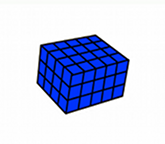Finding the Volume of a Rectangular Prism
|
Student 1: How can we find out how much a three dimensional object can hold inside (its volume)? Mentor: Well, there are different methods for finding volume depending on the three dimensional shape. Let's first look at a box-like shape. How do you think we should solve for the volume of this shape? Student 1: Well, we find the area of a rectangle by multiplying length times width and that shows us how much of a flat rectangle is filled, so maybe we do something like that to find the volume of a three dimensional rectangular shape? Mentor:Good thinking! You are very close. A flat shape is called a two-dimensional shape because it has two dimensions (in the case of a rectangle they are called length and width) while a three dimensional shape will have three dimensions. Let's look at a three dimensional rectangular shape (a rectangular prism):

Mentor:This shape has a length and a width just like you mentioned flat rectangles having, but what else does this three dimensional shape have that flat shapes don't have? What is the extra dimension? Student 2: There is another side that shows you how deep it is. Mentor: Right! This is called the depth! The depth is what makes this a three dimensional figure since there are three dimensions: length, width, and depth! All three of these dimensions are used to find the volume of a rectangular prism. To find the area of a two dimensional rectangle we multiply length by width so lets start with finding the area of a two dimensional part of the rectangular prism. We will first look at the top layer of the rectangular prism when there is length and width, but no depth. Mentor: What is the length (also sometimes called the height) of this shape? Student 1: 3! There are three cubes along the sides going up and down. Mentor:Mentor: Great, so the length is 3. Now what is the width? Student 2:The width is 5! There are five cubes along the sides going left and right. Mentor: That is right! Now we can find the area of this flat shape. What do I do to find the area? Student 2: You multiply the length (3) by the width (5). The answer is 15! Student 1: We need to include the depth! Mentor: Right, let's take another look at our three dimensional shape:

Mentor:See the flat rectangular shape we looked at is only one layer of this big shape. Think about it like this: the flat shape that we just looked at is stacked on other shapes identical to itself. How many of the flat shapes are stacked up in this 3 dimensional figure? Student 1:So our third dimension, depth, is 4? Mentor:Yes. Now, knowing that in the three dimensional shape there are four layers of the flat shape we looked at, and knowing that the flat shape has an area of 15 blocks, how do you think we will find the volume? Student 2: If there are four layers, each with an area of 15, we can add 15+15+15+15 and that will give us the total volume! Student 1: We could also multiply the area of the flat shape, 15, by 4. That is the same thing as adding an area of 15 four times. Mentor:Right! And what do you get when you multiply 15 by 4? Student 1: 60! The volume of the rectangular prism is 60! Mentor:Great job! You found the volume of a rectangular prism. Here are the steps that we took to find our answer:
Mentor: So, in order to find the volume of a rectangular prism we multiply length by width by depth. |
